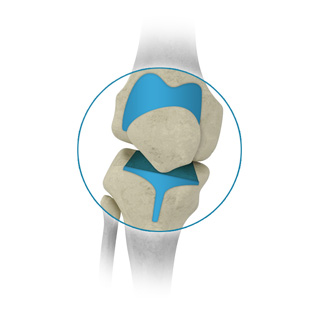
People living with serious knee lesions or severe osteoarthritis should consider surgery via total or partial knee replacement.
This surgery replaces the damaged knee joint with an artificial one (prosthesis). The femoral and tibial parts are connected by the patellar button in order for the patient to regain painless functional capacity for activities such as walking. A convalescence will be necessary, and physiotherapy exercises are mandatory in order to regain full mobility.
Total knee prosthesis
Indications: Osteoarthritis, proven by simple x-ray, that does not respond well to conservative treatment and that changes the patient’s quality of life.
Physiotherapy: 6 to 12 weeks
Convalescence: 6 to 12 weeks
Restrictions: Refrain from practicing impact sports, from jumping and from pivoting
Results: 90 to 95% of very positive results
Longevity: Over 90% of prostheses reach 15 years. 10% have to be adjusted or examined for loosening or other minor issues.
Unicompartimental prosthesis
Indications: Osteoarthritis at the medial compartment only, with a functional ACL
Physiotherapy: 6 weeks
Convalescence: 6 weeks
Restrictions: Few restrictions. Sports allowed
Results: If indication is good, results are good over 95%
Longevity: 90% reach 10 years
Patello-femoral prosthesis
Indications: Significant osteoarthritis at the kneecap, no help from conservative treatments
Physiotherapy: 6 to 12 weeks
Convalescence: 6 to 12 weeks
Restrictions: Few restrictions. Sports are a possibility
Results: Excellent, at 90% and over
Longevity: Only 10 years old. So far, the good results are recurrent.













